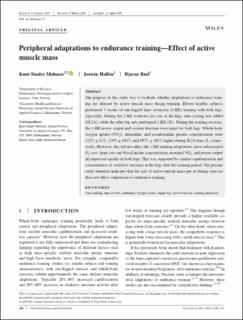Peripheral adaptations to endurance training - Effect of active muscle mass
Peer reviewed, Journal article
Published version
Permanent lenke
https://hdl.handle.net/11250/2650534Utgivelsesdato
2019Metadata
Vis full innførselSamlinger
Sammendrag
The purpose of this study was to evaluate whether adaptations to endurance training are affected by active muscle mass during training. Eleven healthy subjects performed 5 weeks of one‐legged knee extension (1‐KE) training with both legs, separately. During the 1‐KE workouts for one of the legs, arm cycling was added (1L2A), while the other leg only performed 1‐KE (1L). During the training sessions, the 1‐KE power output and session duration were equal for both legs. Whole‐body oxygen uptake (V̇O2), adrenaline, and noradrenaline plasma concentrations were 112% ± 11%, 139% ± 144%, and 197% ± 101% higher during 1L2A than 1L, respectively. However, this did not affect the 1‐KE training adaptations since submaximal O2‐cost, heart rate and blood lactate concentration, maximal V̇O2, and power output all improved equally in both legs. This was supported by similar capillarization and concentration of oxidative enzymes in the legs after the training period. The present study therefore indicates that the size of active muscle mass per se during exercise does not affect adaptations to endurance training.
Beskrivelse
This is an open access article under the terms of the Creative Commons Attribution‐NonCommercial License, which permits use, distribution and reproduction in any medium, provided the original work is properly cited and is not used for commercial purposes.
© 2019 The Authors Translational Sports Medicine Published by John Wiley & Sons Ltd.

